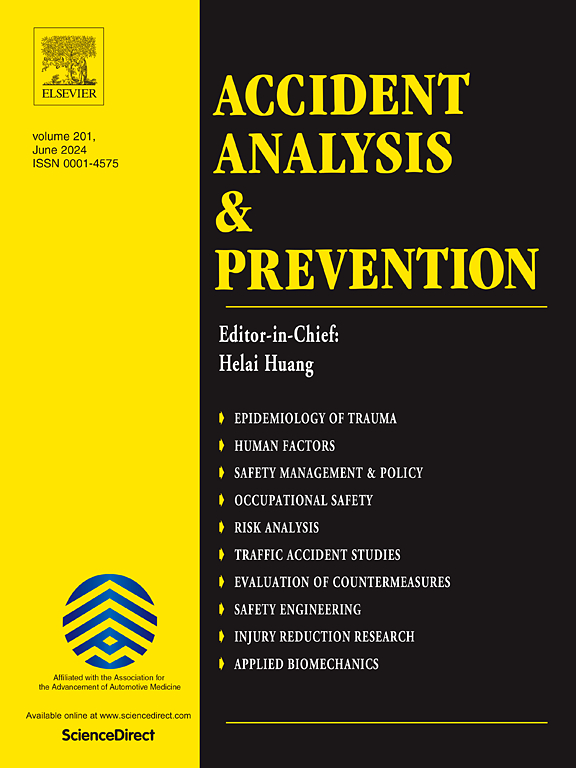为什么预见性传感在切入场景下的商用ACC系统中很重要:从随机安全分析的角度
IF 5.7
1区 工程技术
Q1 ERGONOMICS
引用次数: 0
摘要
本研究提出了自适应巡航控制(ACC)系统在切入场景下的车辆状态演变的解析解,该解结合了使用Lambert W函数的感知延迟和预测。理论分析表明,车辆状态演变及其相应的自动控制系统安全性受到多个因素的影响,包括原领先车辆的状态、自动控制系统的初始条件、后续的自动控制系统的切入机动、感知延迟以及自动控制系统的预判能力。为了定量评估这些影响,研究人员进行了一系列数值实验,对ACC系统进行了随机安全分析,考虑了嵌入式传感延迟和预期,使用了来自真实世界数据的经验校准控制参数。实验表明,感知延迟对ACC的影响是多方面的。具体而言,感知延迟对ACC稳定性有负面影响,且影响程度随延迟的延长而增加。此外,在感应延迟的情况下,插队场景中的碰撞风险变得更加显著,特别是当插队车辆比后面的车辆慢时,以及插队车辆具有侵略性时。然而,预期在减轻这些风险方面起着至关重要的作用。即使只有0.6秒的预判时间,在高度不利的情况下,碰撞风险也可以降低91%。感知延迟和预期的影响都随着时间的延长而加剧。2秒的预期周期有效地确保了在激烈的切入条件下的安全,即使在存在感知延迟的情况下。本文章由计算机程序翻译,如有差异,请以英文原文为准。
Why anticipatory sensing matters in commercial ACC systems under cut-in scenarios: A perspective from stochastic safety analysis
This study presents an analytical solution for the vehicle state evolution of Adaptive Cruise Control (ACC) systems under cut-in scenarios, incorporating sensing delays and anticipation using the Lambert W function. The theoretical analysis demonstrates that the vehicle state evolution and the corresponding safety of ACC in cut-in situations are influenced by multiple factors, including the original leading vehicle’s state, the initial conditions of the cut-in vehicle, subsequent cut-in maneuvers, sensing delays, and the ACC’s anticipation capabilities.
To quantitatively assess these influences, a series of numerical experiments were conducted to perform a stochastic safety analysis of ACC systems, accounting for embedded sensing delays and anticipation, using empirically calibrated control parameters from real-world data. The experiments revealed that the impact of sensing delays on ACC is multifaceted. Specifically, sensing delays negatively affect ACC stability, with the severity increasing as the delay lengthens. Furthermore, collision risk in cut-in scenarios becomes more significant with sensing delays, particularly when the cut-in vehicle is slower than the following vehicle and when cut-ins are aggressive.
However, anticipation plays a crucial role in mitigating these risks. Even with a 0.6-second anticipation, collision risk can be reduced by 91% in highly adverse scenarios. Both sensing delays and anticipation have effects that intensify with their duration. An anticipation period of 2 s effectively ensures safety in aggressive cut-in conditions, even in the presence of sensing delays.
求助全文
通过发布文献求助,成功后即可免费获取论文全文。
去求助
来源期刊

Accident; analysis and prevention
Multiple-
CiteScore
11.90
自引率
16.90%
发文量
264
审稿时长
48 days
期刊介绍:
Accident Analysis & Prevention provides wide coverage of the general areas relating to accidental injury and damage, including the pre-injury and immediate post-injury phases. Published papers deal with medical, legal, economic, educational, behavioral, theoretical or empirical aspects of transportation accidents, as well as with accidents at other sites. Selected topics within the scope of the Journal may include: studies of human, environmental and vehicular factors influencing the occurrence, type and severity of accidents and injury; the design, implementation and evaluation of countermeasures; biomechanics of impact and human tolerance limits to injury; modelling and statistical analysis of accident data; policy, planning and decision-making in safety.
 求助内容:
求助内容: 应助结果提醒方式:
应助结果提醒方式:


